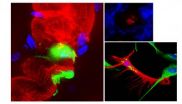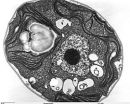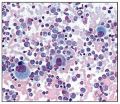(Press-News.org) When it comes to camouflage, ground-nesting Japanese quail are experts. That's based on new evidence published online on January 17 in Current Biology that mother quail "know" the patterning of their own eggs and choose laying spots to hide them best.
"Not only are the eggs camouflaged, but the birds choose to lay their eggs on a substrate that maximizes camouflage," said P. George Lovell of Abertay University and the University of St Andrews. "Furthermore, the maximization seems specific to individual birds."
Karen Spencer, also of University of St Andrews and a co-author, had earlier noticed that female quail lay eggs that vary a lot in appearance, and that those differences are repeatable. Some birds consistently lay eggs covered in dark spots; others have many fewer spots or, in some cases, almost none at all.
That pattern led the researchers to an intriguing idea: that birds might make optimal egg-laying choices based on the special characteristics of their own eggs. To find out, they gave female quail in the lab a choice between four different backgrounds on which to lay their eggs.
Those choice experiments revealed that most quail mothers lay their eggs on background colors to match the spots on their eggs. That's an effective strategy known as disruptive coloration, in which contrasting patterns on surfaces make the outline of an object harder to detect. Birds laying eggs with little patterning instead choose lighter surfaces to match the predominant background color of their eggs.
The findings suggest that quail in the wild lower the chance that their eggs will be found and eaten by predators through careful decision-making, the researchers say.
"Animals make choices based upon their knowledge of the environment and their own phenotype to maximize their ability to reproduce and survive," Lovell said. "In this specific case, birds know what their eggs look like and can make laying choices that will minimize predation."
INFORMATION:
Current Biology, Lovell et al.: "Individual quail select egg-laying substrate providing optimal camouflage for their egg phenotype."
Quail really know their camouflage
2013-01-17
ELSE PRESS RELEASES FROM THIS DATE:
New insights into how leprosy infection spreads could pave the way for early intervention
2013-01-17
Leprosy is a bacterial disease that spreads to muscles and other tissues in the body, causing neurodegeneration and muscle weakness. A new study, published by Cell Press January 17th in the journal Cell, reveals that the bacteria responsible for leprosy spread infection by hijacking specialized cells in the adult nervous system, reprogramming them into a stem cell-like state, and converting them to muscle-like cells. These findings could lead to the development of new therapeutic strategies for combating bacterial infections and degenerative diseases as well as new tools ...
Learning the alphabet of gene control
2013-01-17
Scientists at Karolinska Institutet in Sweden have made a large step towards the understanding of how human genes are regulated. In a new study, published in the journal Cell, they identified the DNA sequences that bind to over four hundred proteins that control expression of genes. This knowledge is required for understanding of how differences in genomes of individuals affect their risk to develop disease.
After the human genome was sequenced in 2000, it was hoped that the knowledge of the entire sequence of human DNA could rapidly be translated to medical benefits ...
Cancer mortality down 20 percent from 1991 peak
2013-01-17
Atlanta– Jan. 17, 2013–As of 2009, the overall death rate for cancer in the United States had declined 20 percent from its peak in 1991, translating to the avoidance of approximately 1.2 million deaths from cancer, 152,900 of these in 2009 alone. These figures come from the American Cancer Society's annual Cancer Statistics report, one of the most widely-cited medical publications in the world.
Each year, the American Cancer Society estimates the numbers of new cancer cases and deaths expected in the United States in the current year and compiles the most recent data ...
How cells know when it's time to eat themselves
2013-01-17
Researchers at the University of California, San Diego School of Medicine have identified a molecular mechanism regulating autophagy, a fundamental stress response used by cells to help ensure their survival in adverse conditions.
The findings are published online in the January 17 issue of Cell.
Senior author Kun-Liang Guan, PhD, a professor of pharmacology at UC San Diego Moores Cancer Center, and colleagues report that an enzyme called AMPK, typically involved in sensing and modulating energy use in cells, also regulates autophagic enzymes.
Autophagy, which derives ...
Drug targets hard-to-reach leukemia stem cells responsible for relapses
2013-01-17
Researchers at the University of California, San Diego School of Medicine have discovered that hard-to-reach, drug-resistant leukemia stem cells (LSCs) that overexpress multiple pro-survival protein forms are sensitive – and thus vulnerable – to a novel cancer stem cell-targeting drug currently under development.
The findings, published in the January 17 online issue of Cell Stem Cell, open the possibility that diseases like chronic myeloid leukemia (CML) and some solid tumor cancers might – in combination with other therapies – be more effectively treated with this ...
Mount Sinai researchers discover how the flu virus tells time
2013-01-17
Scientists have discovered that that the flu virus can essentially tell time, thereby giving scientists the ability to reset the virus' clock and combat it in more effective ways. According to researchers at the Icahn School of Medicine at Mount Sinai, the flu knows how much time it has to multiply, infect other cells, and spread to another human being. If it leaves a cell too soon, the virus is too weak. If it leaves too late, the immune system has time to kill the virus.
The finding provides a novel design platform for the flu vaccine and could lead to new antiviral ...
Deodorants: Do we really need them?
2013-01-17
New research shows that more than 75 per cent of people with a particular version of a gene don't produce under-arm odour but use deodorant anyway.
The study was based on a sample of 6,495 women who are part of the wider Children of the 90s study at the University of Bristol. The researchers found that about two per cent (117 out of 6,495) of mothers carry a rare version of a particular gene (ABCC11), which means they don't produce any under-arm odour.
While about 5 per cent of people who produce an odour do not use deodorant, more than a fifth (26 out of 117) of ...
Gastric banding an effective long-term solution to obesity
2013-01-17
Laparoscopic adjustable gastric banding – lap banding – is a safe and effective long-term strategy for managing obesity, according to the findings of a landmark 15-year follow-up study of patients treated in Australia.
The follow-up study, the longest and most comprehensive yet reported, was published in the Annals of Surgery, and found a significant number of lap band patients maintained an average weight loss of 26 kilograms for more than a decade after their procedure.
Professor Paul O'Brien and colleagues from the Centre for Obesity Research and Education (CORE) ...
'Jet-lagged' fruit flies provide clues for body clock synchronisation
2013-01-17
New research led by a team at Queen Mary, University of London, has found evidence of how daily changes in temperature affect the fruit fly's internal clock.
"A wide range of organisms, including insects and humans, have evolved an internal clock to regulate daily patterns of behaviour, such as sleep, appetite, and attention," explains Professor Ralf Stanewsky, senior study author from Queen Mary's School of Biological and Chemical Sciences.
"Research on animal and human clocks shows that they are fine tuned by natural and man-made time cues, for example the daily ...
Genetic admixture in southern Africa
2013-01-17
This press release is available in German.
An international team of researchers from the MPI for Evolutionary Anthropology in Leipzig and the CNRS in Lyon have investigated the maternally inherited mitochondrial DNA of 500 individuals from southern Africa speaking different Khoisan and Bantu languages. Their results demonstrate that Khoisan foragers were genetically more diverse than previously known. Divergent mtDNA lineages from indigenous Khoisan groups were incorporated into the genepool of the immigrating Bantu-speaking agriculturalists through admixture, and have ...




